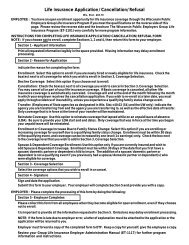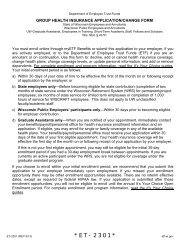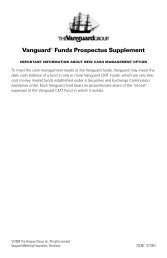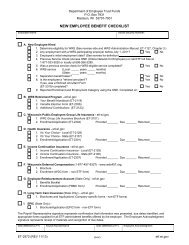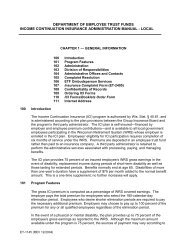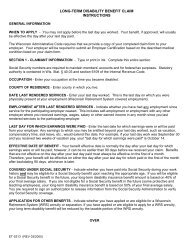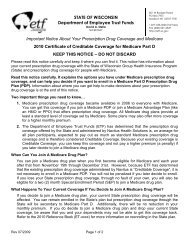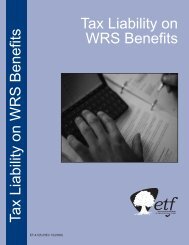Chapter 22 â Uniformed Services Subject to Retirement Credit - ETF
Chapter 22 â Uniformed Services Subject to Retirement Credit - ETF
Chapter 22 â Uniformed Services Subject to Retirement Credit - ETF
Create successful ePaper yourself
Turn your PDF publications into a flip-book with our unique Google optimized e-Paper software.
Department of Employee Trust Funds<br />
WISCONSIN RETIREMENT SYSTEM ADMINISTRATION MANUAL<br />
CHAPTER <strong>22</strong> — <strong>Uniformed</strong> <strong>Services</strong> <strong>Subject</strong> <strong>to</strong> <strong>Retirement</strong> <strong>Credit</strong><br />
<strong>22</strong>00 <strong>Uniformed</strong> <strong>Services</strong> Employment and Reemployment Rights Act of 1994<br />
<strong>22</strong>01 <strong>Uniformed</strong> <strong>Services</strong><br />
<strong>22</strong>02 Examples of Military Service<br />
<strong>22</strong>03 Periods of <strong>Uniformed</strong> Service when Employees Become Eligible for<br />
<strong>Retirement</strong> <strong>Credit</strong><br />
<strong>22</strong>04 <strong>Retirement</strong> <strong>Credit</strong><br />
<strong>22</strong>05 Employee Responsibility <strong>to</strong> Receive Military Service <strong>Credit</strong><br />
<strong>22</strong>06 Employer Reporting<br />
<strong>22</strong>07 Death Benefits for Certain Inactive WRS Participants (HEART Act)<br />
<strong>22</strong>00 <strong>Uniformed</strong> <strong>Services</strong> Employment and Reemployment Rights Act<br />
of 1994<br />
The <strong>Uniformed</strong> <strong>Services</strong> Employment and Reemployment Rights Act of 1994 (USERRA)<br />
is a federal law providing certain pension rights <strong>to</strong> employees returning from uniformed<br />
service. USERRA generally provides service credit and Wisconsin <strong>Retirement</strong> System (WRS)<br />
contributions related <strong>to</strong> a military leave of absence when an employee leaves a WRS-covered<br />
position with an employer for active military duty and returns <strong>to</strong> that same employer within a<br />
specific time frame.<br />
The United States Department of Labor considers USERRA <strong>to</strong> be a restatement and clarification<br />
of veterans’ reemployment rights laws dating back <strong>to</strong> 1940. USERRA’s reemployment provisions<br />
were effective December 12, 1994. Prior <strong>to</strong> that date, previous federal or state veterans’<br />
reemployment rights laws may apply.<br />
Note: Refer <strong>to</strong> subchapter 2001 for other Military Service credit.<br />
<strong>22</strong>01 <strong>Uniformed</strong> <strong>Services</strong><br />
• Armed Forces<br />
• Army and Air National Guard, when engaged in active duty for training, inactive duty training<br />
or full-time National Guard duty<br />
• Commissioned corps of the Public Health Service<br />
• Any other category of persons designated by the President in time of war or emergency<br />
ET-1127 (<strong>Chapter</strong> <strong>22</strong> Revised 1/14)
Wisconsin <strong>Retirement</strong> System<br />
<strong>Chapter</strong> <strong>22</strong> — <strong>Uniformed</strong> <strong>Services</strong> <strong>Subject</strong> <strong>to</strong> <strong>Retirement</strong> <strong>Credit</strong><br />
<strong>22</strong>02 Examples of Military Service<br />
• Army<br />
• Army Reserve<br />
• Marine Corps<br />
• Marine Corps Reserve<br />
• Air Force<br />
• Air Force Reserve<br />
• Navy<br />
• Navy Reserve<br />
• Coast Guard<br />
• Commissioned Officer of U.S. Public Health Service<br />
<strong>22</strong>03 Periods of <strong>Uniformed</strong> Service when Employees Become Eligible<br />
for <strong>Retirement</strong> <strong>Credit</strong><br />
• Active duty<br />
• Active duty for training<br />
• Inactive duty for training which includes weekend drills if part of normal work schedule<br />
• Annual training<br />
• Training for which orders were given<br />
• Volunteer or required active duty military service or training<br />
• Time a person is absent for the purposes of a fitness exam<br />
<strong>22</strong>04 <strong>Retirement</strong> <strong>Credit</strong><br />
USERRA provides for WRS service credit and contributions in the amount the employee would<br />
have received had the employee been continuously employed with their WRS participating<br />
employer.<br />
WRS Contributions<br />
Upon reemployment, the employee is responsible for paying any missed WRS<br />
Employee-Required Contributions (EERC) unless the employee had been covered by a<br />
collective bargaining agreement providing that the employer would make those contributions.<br />
The employee has the choice <strong>to</strong> make all, some, or none of the make-up EERC related <strong>to</strong> the<br />
military leave. Employers must submit WRS Employer-Required Contributions (ERRC) <strong>to</strong> match<br />
the EERC the employee chooses <strong>to</strong> make. The employer is also required <strong>to</strong> fund any additional<br />
obligations, including interest that would have accrued on the ERRC and EERC, once those<br />
contributions are remitted.<br />
USERRA allows for make-up EERC <strong>to</strong> the WRS <strong>to</strong> be made beginning with the date of<br />
reemployment and ending on the earlier of three times the period of military service or five<br />
years. USERRA specifies that make-up contributions are only allowed while the returning<br />
employee is employed with the pre-military service employer.<br />
ET-1127 (<strong>Chapter</strong> <strong>22</strong> Revised 1/14)
Wisconsin <strong>Retirement</strong> System<br />
<strong>Chapter</strong> <strong>22</strong> — <strong>Uniformed</strong> <strong>Services</strong> <strong>Subject</strong> <strong>to</strong> <strong>Retirement</strong> <strong>Credit</strong><br />
The required WRS contributions are based on the earnings the employee would have made<br />
had the employee not been absent from work <strong>to</strong> fulfill obligations in the uniformed services. The<br />
computation is not based on what the employee earned from the uniformed service.<br />
WRS Service <strong>Credit</strong><br />
The returning employee will receive WRS service credit for time spent on active military duty<br />
whether or not any make-up contributions are made. With limited exceptions, the maximum<br />
amount of USERRA credit an employee may receive is five years (for federal exceptions <strong>to</strong><br />
the five-year limit, please visit the U.S. Department of Labor website at www.dol.gov/vets/, or<br />
contact <strong>ETF</strong> <strong>to</strong>ll free at 1-877-533-5020)<br />
To apply for USERRA credit, the employee and employer must submit a USERRA Certification<br />
form (ET-4560) <strong>to</strong> <strong>ETF</strong>.<br />
<strong>22</strong>05 Employee Responsibility <strong>to</strong> Receive Military Service <strong>Credit</strong><br />
For employees <strong>to</strong> receive USERRA credit for their military service, they must meet the following<br />
conditions:<br />
1. Notify the employer that they are going on military leave, unless such notice was precluded<br />
by military necessity or otherwise impossible or unreasonable.<br />
2. Leave the military under honorable conditions.<br />
3. Return <strong>to</strong> the same employer within the following time limits, unless that timely return or<br />
re-application for employment was impossible or unreasonable, for leaves which are one of<br />
the following:<br />
• Fewer than 31 days; report <strong>to</strong> work the next regularly scheduled workday after receiving<br />
adequate travel and rest.<br />
• 31 <strong>to</strong> 180 days; return <strong>to</strong> work within 14 days after completion of service.<br />
• More than 180 days; return <strong>to</strong> work within 90 days after completion of service.<br />
• Service-connected injury or illness: Reporting or application deadlines are extended for<br />
up <strong>to</strong> two years for persons who are hospitalized or convalescing.<br />
4. Provide the employer with a copy of military papers showing the date of entry and the date of<br />
discharge.<br />
For more information about USERRA reporting requirements, please refer <strong>to</strong> the United States<br />
Department of Labor website at www.dol.gov.<br />
To receive WRS credit, the employer and employee must submit USERRA Certification form<br />
(ET-4560) <strong>to</strong> <strong>ETF</strong>.`<br />
ET-1127 (<strong>Chapter</strong> <strong>22</strong> Revised 1/14)
Wisconsin <strong>Retirement</strong> System<br />
<strong>Chapter</strong> <strong>22</strong> — <strong>Uniformed</strong> <strong>Services</strong> <strong>Subject</strong> <strong>to</strong> <strong>Retirement</strong> <strong>Credit</strong><br />
<strong>22</strong>06 Employer Reporting<br />
Prior <strong>to</strong> the implementation of 2011 Wisconsin Acts 10 and 32, <strong>ETF</strong> provided employers with two<br />
reporting options for employees electing their USERRA rights for their military leave:<br />
1. Place the employee on an unpaid leave of absence, or;<br />
2. Continue <strong>to</strong> report the employee’s deemed hours and earnings as if the employee were an<br />
active employee.<br />
Acts 10 and 32 altered how <strong>ETF</strong> processes employee and employer required contributions<br />
related <strong>to</strong> a military leave of absence. Absent a collective bargaining agreement with provisions<br />
<strong>to</strong> the contrary, the Acts provide that the employee is responsible for making WRS employee<br />
required contributions. As a result, if an employee is not covered by a collective bargaining<br />
agreement under which the employer pays the <strong>to</strong>tal amount of the employee required<br />
contributions, employers may no longer continue <strong>to</strong> report an employee on military leave as an<br />
active WRS employee and remit contributions on that employee’s behalf.<br />
<strong>ETF</strong> offers the following guidelines for employers with employees currently on a military leave of<br />
absence, or with employees who left on a military leave of absence subsequent <strong>to</strong> the effective<br />
date of the WRS Employee-Required Contribution (EERC) payroll deductions in August of 2011:<br />
1. If the employer is required <strong>to</strong> continue <strong>to</strong> pay the WRS EERC, the employer may continue<br />
<strong>to</strong> report that employee as active and remit both the WRS Employer-Required Contribution<br />
(ERRC) and EERC. Examples would include certain public safety employees and<br />
employees who remain under a collective bargaining agreement that specifies that the<br />
employer will pay the EERC on behalf of the employee, or;<br />
2. If the employee is required <strong>to</strong> pay their own EERC, the employer must place that employee<br />
on a military leave of absence, reporting with an Action Code 50 on the employer’s year-end<br />
annual report. No WRS ERRC or EERC are remitted when the employee is on military<br />
leave.<br />
Once an employee returns <strong>to</strong> work with their pre-military leave of absence employer, the<br />
employer is required <strong>to</strong> submit the USERRA Certification form (ET-4560) along with a copy<br />
of military-issued papers reflecting the employee’s entry and discharge dates, such as the<br />
employee’s DD-214. If the employee was not covered under a collective bargaining agreement<br />
providing that the employer would pay the WRS EERC, the employee will have the choice<br />
whether <strong>to</strong> make up all, some, or none of the missed EERC. The employer must then match<br />
whatever contributions the employee chooses <strong>to</strong> make up. <strong>ETF</strong> provides a USERRA Make-up<br />
Contributions Monthly Tracking Report (ET-2573) for an employer <strong>to</strong> report required ERRC and<br />
EERC.<br />
For more information, please see the instructions available on <strong>ETF</strong>’s website entitled<br />
Employer Reporting for an Employee on a Military Leave of Absence, or contact the Employer<br />
Communication Center <strong>to</strong>ll free at 1-877-533-5020 or locally at 608-266-3285.<br />
ET-1127 (<strong>Chapter</strong> <strong>22</strong> Revised 1/14)
Wisconsin <strong>Retirement</strong> System<br />
<strong>Chapter</strong> <strong>22</strong> — <strong>Uniformed</strong> <strong>Services</strong> <strong>Subject</strong> <strong>to</strong> <strong>Retirement</strong> <strong>Credit</strong><br />
<strong>22</strong>07 Death Benefits for Certain Inactive WRS Participants (HEART<br />
Act)<br />
On June 17, 2008, the federal “Heroes Earnings Assistance and Relief Tax Act” (HEART Act)<br />
became effective. This federal legislation is retroactive <strong>to</strong> January 1, 2007, and affects the death<br />
benefits payable <strong>to</strong> the survivors of participants who die as “inactive” Wisconsin <strong>Retirement</strong><br />
System (WRS) participants while on active military duty.<br />
“Inactive” WRS death benefits consist of the employee required contribution balance plus any<br />
voluntary additional contributions. “Active” WRS death benefits generally include the employee<br />
required contribution balance plus a matching amount of employer contributions, and any<br />
voluntary additional contributions.<br />
Under the HEART Act, when a WRS participant terminates employment <strong>to</strong> enter the<br />
military and then dies in active military service, the death benefit must be calculated as<br />
though he/she returned <strong>to</strong> employment on the date of death and treated as an “Active”<br />
WRS death.<br />
This means that the WRS death benefit would also include the matching employer contributions,<br />
which, in most situations, will double the death benefit.<br />
Since the HEART Act is retroactive <strong>to</strong> January 1, 2007, it applies <strong>to</strong> deaths that occurred<br />
on or after that date.<br />
Note: If the participant was on a leave of absence during the period of military service (rather<br />
than terminated), and died while on a leave of absence, the HEART Act has no effect<br />
because the death benefits will already be calculated as a death in “Active” WRS<br />
employment.<br />
For questions regarding the HEART Act, contact the Employer Communication Center <strong>to</strong>ll free<br />
at 1-877-533-5020 or locally at 608-266-3285.<br />
ET-1127 (<strong>Chapter</strong> <strong>22</strong> Revised 1/14)




